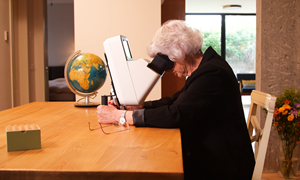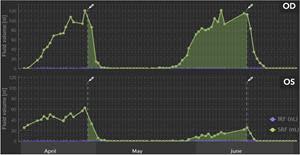Efficacy of Notal Vision Home OCT demonstrated by a series of scientific and clinical work
Multiple investigators show effectiveness of Home-OCT based remote monitoring model
Notal Vision's home-based OCT

Notal OCT Analyzer (NOA)

Manassas, VA, June 29, 2022 (GLOBE NEWSWIRE) -- Notal Vision, Inc. reported today that numerous scientific and clinical publications and presentations prove the feasibility and efficacy of their patient-operated, home-based optical coherence tomography (OCT) device. As part of a comprehensive remote monitoring service, which includes a monitoring center and artificial intelligence algorithms for information processing, the Notal Home OCT effectively monitors wet age-related macular degeneration (AMD) treatment between doctor’s office visits.
Wet AMD is the leading cause of blindness in people over 50 in the United States. Several treatments have been developed over the last two decades and have proven to be extremely beneficial. However, therapy requires frequent office visits for disease monitoring, placing a major burden on physicians, patients, and their caregivers. This burden has contributed to the limited real-world efficacy of these treatments.
Home monitoring using standard of care OCT technology is expected to optimize treatment regimens for these patients and provide better vision outcomes. The key challenges for home OCT technology include demonstrated correlation with in-office devices, full self-operation by the patients, convenient use in a home setting, continuous patient compliance, and the ability to extract meaningful information from the high-volume data being generated. The investigational Notal Home OCT device, which received an FDA breakthrough designation, is the leading pipeline technology for monitoring wet AMD treatments.
A series of studies using Notal Vision’s Home OCT have shown that the device is effective in overcoming each of these challenges. A prospective and cross-sectional study recently published in BMC Ophthalmology, which included 333 wet AMD patients and 600 eyes, demonstrated the ability of patients to self-image in a clinic setting, with over 91% of patients being able to successfully acquire images without technician assistance. The imaging showed excellent correlation with in-office OCT for detecting the presence of fluid, an important biomarker in wet AMD, with over 95% agreement.1
“We were very surprised by Home OCT’s self-imaging success rate and the patient response,” said Dr. David Lally from the Retina Research Institute at New England Retina Consultants, Springfield, MA. “Patients with limited vision were able to self-image with no assistance, and most patients felt that use of the device was much easier than they initially anticipated. I think after imaging nearly 600 eyes with Home OCT, we can be confident in its capability to produce reliable images with patient self-operation.”
A prospective and longitudinal study to understand patients’ ability to self-image in a home setting with no prior training was conducted by prominent retina specialists Jeffrey Heier, MD and Nancy Holekamp, MD.2 The program enrolled 15 wet AMD patients and the device was shipped to their homes by the Notal Vision Monitoring Center. Subjects were able to set up the device themselves and perform daily scans with the support of the Monitoring Center clinical staff. Patients demonstrated extraordinary self-imaging capability, with a total of 2,300 scans taken at a 95% success rate. Yingna Lui, MD recently presented the results from this study at the Association for Research in Vision and Ophthalmology (ARVO) annual meeting, which also demonstrated the importance of home-based OCT data for better disease management in patients, reviewing specific remote monitoring case studies. The US study followed a prospective longitudinal pilot study conducted in Israel by Anat Loewenstein, MD and colleagues in 2020 and published in Ophthalmology Science.3
Patient compliance was also studied in the Heier and Holekamp longitudinal study. Patients performed an average of 5.8 exams per week, demonstrating strong compliance to ensure any exudation of fluid, critical to wet AMD management, was promptly captured. Patients were asked to assess their satisfaction of Home OCT as part of the study and rated it neutral to highly satisfactory on over 95% of questions, and highly agreed on convenience and ease of use.
“The Notal Vision Monitoring Center shipped the device directly to patients and managed all their training and patient questions – no training was provided by our site,” said Dr. Jeffrey Heier, director of the retinal service and retinal research at Ophthalmic Consultants of Boston. “Physicians reviewed the AI-generated data from the device using a web-based viewer. This technology has the potential to allow clinicians daily assessment of fluid status, earlier recognition of recurrent activity, and can reduce the significant burden currently placed on patients, caregivers, and their providers.”
Home OCT cannot be adopted by doctors without the ability to distill the large volumes of images generated by the device into actionable information. This process is managed by the AI-powered Notal OCT Analyzer (NOA). Fluid regions captured by Home OCT’s B-scans are segmented and quantified by NOA and these volumes, an important biomarker in wet AMD, are studied over time. NOA’s performance was demonstrated by Michael Elman, MD and Sid Schechet, MD during a 26-patient study they conducted, in which patient self-acquired scans were analyzed using NOA and compared with expert-graded commercial OCT scans. Presented by Dr. Elman at the ARVO annual meeting, the results found a high correlation of over 97% between the NOA and manually graded OCT scans. This study further demonstrates the capability of the AI-based algorithm for fluid quantification in wet AMD patients.
“We are excited to see multiple investigators evaluating different aspects of our investigational Home OCT platform,” said Kester Nahen, PhD, CEO of Notal Vision. “This is further validation of the efficacy of our digital health-based remote monitoring model, which we currently use for the ForeseeHome AMD Monitoring Program. We believe we have perfected the various components of the model over the past ten years, which has greatly helped us bring this impactful technology closer to market.”
Notal Vision’s home-based OCT pipeline technology has received an FDA Breakthrough Device designation and is in the process of obtaining FDA clearance. In January 2020 the American Medical Association established three category III Current Procedural Terminology (CPT®) codes for reporting patient-initiated remote retinal OCT scans, facilitated by Notal Vision’s home-based OCT. The physician review, interpretation and documentation of AI-based analyses will be billable every 30 days.
References
Kim JE, Tomkins-Netzer O, Elman MJ, Lally DR, et al. Evaluation of a self-imaging SD-OCT system designed for remote home monitoring. BMC Ophthalmol 22, 261 (2022). https://doi.org/10.1186/s12886-022-02458-z
Liu Y, Holekamp NM, Heier JS. Prospective, Longitudinal Study: Daily Self-Imaging with Home OCT for Neovascular Age-Related Macular Degeneration. Ophthalmology Retina, 2022. https://doi.org/10.1016/j.oret.2022.02.011.
Keenan TDL, Goldstein M, Goldenberg D, Zur D, Shulman S, Loewenstein A, Prospective, Longitudinal Pilot Study Daily Self-Imaging with Patient-Operated Home OCT in Neovascular Age-Related Macular Degeneration. Ophthalmology Science 2021;1:100034. https://doi.org/10.1016/j.xops.2021.100034
About Notal Vision
Notal Vision is a patient-centric ophthalmic remote monitoring services provider extending retinal disease monitoring from the clinic to the home, providing physicians with remote monitoring services to support their patient care between office visits. With a proven approach to home-based, self-operated diagnostics, AI-enabled data analysis, and patient engagement, we help preserve patients’ vision. www.notalvision.com
The Notal Vision Monitoring Center is a remote, Medicare credentialed ophthalmic monitoring center and the epicenter of patient engagement. Led by practicing ophthalmologists and supported by certified ophthalmic professionals, the Monitoring Center offers a comprehensive nationwide age-related macular degeneration (AMD) home monitoring service for referred patients.
The ForeseeHome® AMD Monitoring Program is a comprehensive program, which includes an FDA-cleared device that monitors visual changes in intermediate dry AMD patients at risk of vision loss from undiagnosed wet AMD. The clinical utility for ForeseeHome was established in the Home Monitoring of The Eye (HOME) Study, part of the National Eye Institute-sponsored AREDS2 study, in which 94% of patients using ForeseeHome twice weekly who progressed to wet AMD, maintained 20/40 or better vision compared to only 62% of patients whose diagnosis was at a routine eye exam, or a visit triggered by symptoms. Based upon the robust level-1 evidence and compelling clinical outcomes demonstrating the ability to detect choroidal neovascularization (CNV) earlier, the ForeseeHome AMD Monitoring Program gained Medicare coverage in 2016. To learn more, visit www.foreseehome.com.
Notal Vision’s Home OCT system will enable wet AMD patients to perform technician-free OCT testing at home with rapid and self-guided fixation – critical components, especially for elderly patients frequently with pre-existing vision loss. The Notal OCT Analyzer (NOATM), a proprietary machine learning algorithm, developed in-house, performs automated analysis of the Home OCT scans and generates a report to the physician when a physician specified change in disease activity is detected. The Notal Vision Monitoring Center provides referring physicians patient data via an online portal. In addition, physicians will be provided 24/7 access to all of their patients' B-scan images from each Home OCT test with the location of the fluid annotated on each B-scan. Following physician receipt of an alert report, patients may be brought to the office for evaluation and treatment at the doctor’s discretion. NOA can also analyze the output of other commercial OCT devices, and published study data indicate that the performance of NOA in detecting disease activity was like that of retina physicians when each was compared to a panel of experts. Notal Vision’s Home OCT has the potential to support current and future advances in retinal disease management.
###
Attachments
CONTACT: Candice Morin Notal Vision 4012846378 candicem@notalvision.com


 Yahoo Finance
Yahoo Finance 